Abstract
The issue of the impact of new technologies use on the labor productivity growth takes on relevance in the digital economy. The article discusses the problem of the labor productivity and wages growth rates dependence, expressed through the coefficient of outstripping growth. This dependence has been analyzed based on data of leading countries on labor productivity (Ireland, Luxembourg, Great Britain, USA), as well as Russia and Mexico. There was revealed that labor productivity growth rates exceeded the wages growth rates in most countries, but Russia and Mexico. This observation is seen against the background of studies that show that innovatively developed countries has much lower correlation between labor productivity and wages than in innovatively undeveloped countries. This is largely due to the influence of other factors in the expansion of innovation. These factors relate not only to the spheres of economics and management, but are largely determined by the space’s configuration of social and personal life of a person. However, the technocratic approach prevails over historical experience and underestimates the humanitarian component. Disclosure of personal potential, creativity and consciousness of labor are important aspects of a person's work. So, authors suggest that humanitarian aspects should be taken into account when making management decisions in the field of labor productivity growth. To increase labor productivity, it is necessary to realize the full range of opportunities, and anthropological foundations should be put at the forefront.
Keywords: Labor productivityoutstripping growth rateinnovatively developed countrieshumanitarian aspects
Introduction
As most of researchers mention, the trends of economy and society development have a strong correlation with the digitalization process (Bodrunov et al., 2018; Volkova et al., 2019). The digital technologies penetrate into all the spheres of society life, influencing the structure and content of economic processes. The improvement and development of information technologies is becoming a major factor in the economic development of countries. A common information space contributes to “economic growth and increased labor productivity” (Prokopyeva et al., 2018), creation of workplaces and digital assets.
In the modern world the digital economy is thriving. The manufacturing sector of the digital economy is also growing. Using digital technologies (big data, artificial intelligence etc.) for automation of production process transforms this process and models of industrial and technological cooperation accelerates production of various products, performing works and providing services and reduces their cost (Prokopyeva et al., 2018). It allows to open a new way to use human potential, but at the same time it can give rise to social problems associated with the disappearance of a number of mass, so called traditional professions. Many existing industries lose their importance in the structure of the world economy against the backdrop of rapid growth in new sectors, generating entirely new needs
In these conditions, the questions of the influence of new technologies on the growth of labor productivity as one of the most important indicators of the economic development of a country, come to the fore. In this paper we analyze the issue of inter-relation between labor productivity and salary in different countries as an indicator of changes in the most important macroeconomic proportions, such as production and consumption, consumption and saving, the creation of means of production and articles of consumption. Without growth of labor productivity it is impossible to solve the main macroeconomic problems. Salary, in its turn, depends not only on the growth rate of production and increasing of labor productivity, but also on the qualification, interest of the employees in their work, their motivation to fulfill the tasks they are entrusted with, motivation for self-realization and professional development.
In light of this, a following question arises: What excess of growth rates of labor productivity over the salary growth rates is necessary and sufficient to ensure sustainable growth and development of the digital economy?
For example, in the USA and Canada from 1961 to 2007 there was a slightly larger increase in labor productivity than salary growth. In the OECD countries from 1970 to 2006 growth of productivity and salary growth were almost identical (Sharpe et al., 2008). Abroad, the principle of outstripping growth rate of labor productivity is enshrined in the individual systems of payment for labor (Babin & Grishkovets, 1993). In the USSR, much attention was paid to this principle. When creating the mechanism for the formation of the payroll fund, the relevant lead coefficient was used.
The Russian economy is marked by a significantly lower level of labor productivity than in developed countries, and in a number of developing countries labor productivity is several-fold higher (Labor productivity in Russia…, 2016). For example, in 2018, GDP production per hour in Ireland and Luxembourg, which are the leading countries based on this indicator, amounted to 105.1 and 104.1 US dollars, respectively (OECD. Stat., 2020). In the USA this indicator amounted to 74.4 US dollars, in the UK it was 62.4 US dollars, in Japan it reached 45.4 US dollars. In Russia, labor productivity was $ 26.1, and only in Chile and Mexico comparable figures of $ 28.5 and $ 22.3, respectively, were shown. This indicator reflects the volume of GDP produced by each worker for one hour of work (with current prices, according to purchasing-power parity).
Methods
This situation is indicative of a necessity to analyze the correlation of levels and dynamics of labor productivity and salary in different countries to understand the problems and consequences in the formation and development of the digital economy.
As it is known, the outstripping growth in labor productivity compared with salary growth indicates that there are rational proportions in the economy. In case of violation of this principle, we can talk about over-expenditure of the payroll fund, which leads to an increase in the prime cost, and as a result, a decrease in profit.
The ratio between the growth of labor productivity and average salaries is expressed in the form of a known lead factor (Kоп). It is traditionally defined as the ratio of two indices - the labor productivity index (Iпт) and the average salary index (Iзп):
(1)
In the professional literature there are 4 situations, which are usually singled out (Figure
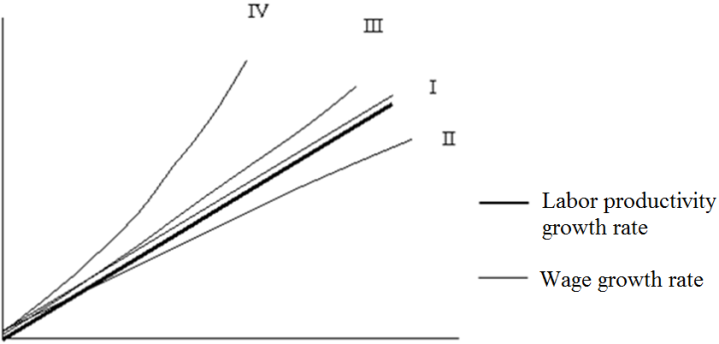
Situation 1. IПТ is almost equal to IЗП (Figure
Situation 2. IПТ > IЗП. This situation (Figure
Situation 3. IПТ < IЗП. Such a model stimulates the growth of labor productivity, but generates inflation (Figure
Situation 4. IЗП significantly < IПТ. Too high salary growth rates (Figure
In order to identify the real ratio of the growth rates of labor productivity and salary, we will analyze the data about various countries for the period 2008-2018.
For comparison, we took advanced countries from the point of view of labor productivity, such as Ireland and Luxembourg, developed countries like the USA, Great Britain and Japan, and developing countries like Russia and Mexico. Tables
Results
Figures
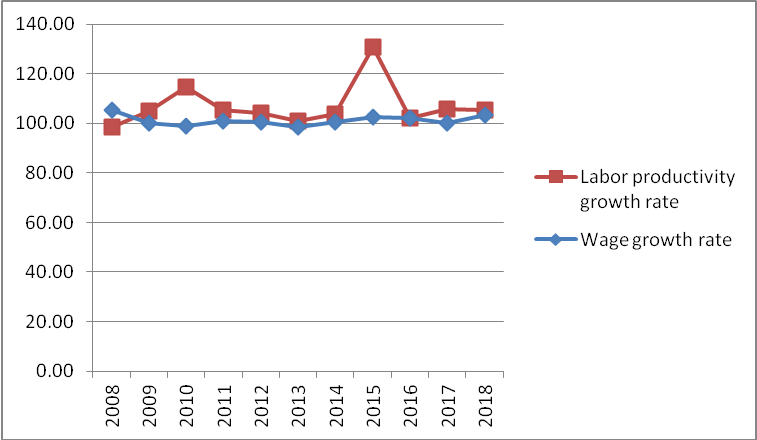
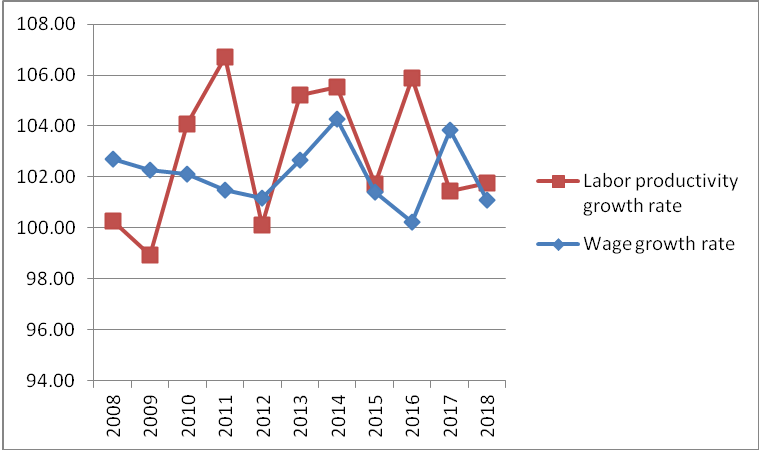
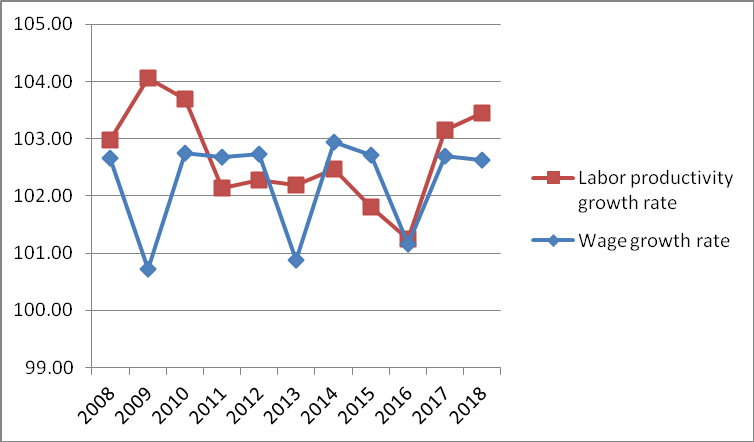
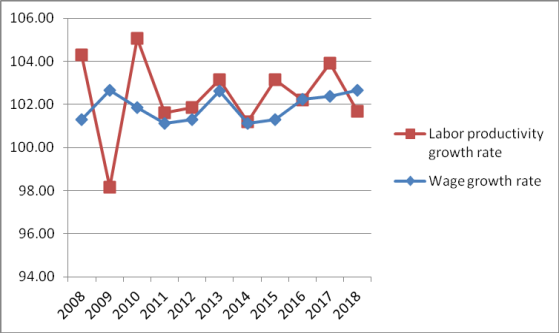
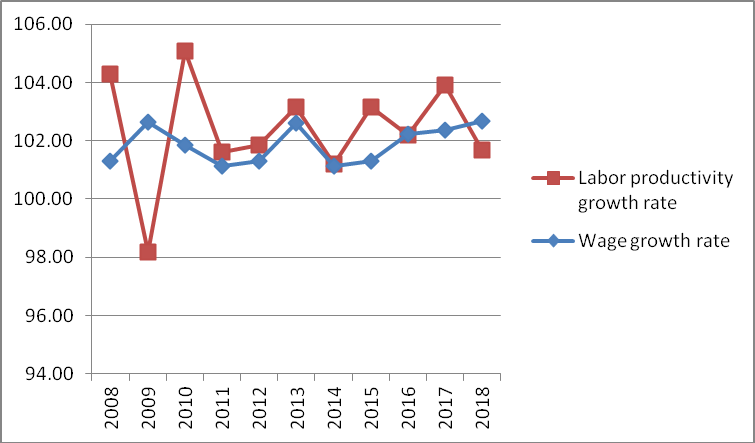
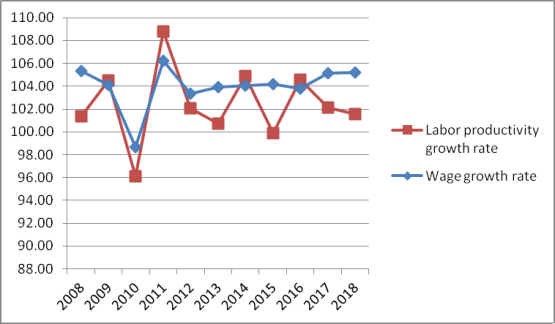
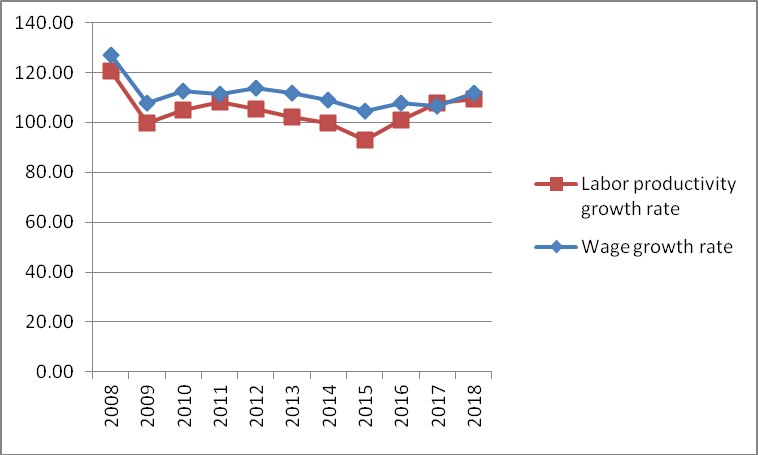
As can be noted, in developed countries, as a rule, the growth rate of labor productivity exceeds the growth rate of salary. The reverse situation can be observed only during periods of crisis and decrease in the level of labor productivity. For example, in Ireland, salary growth rates exceed labor productivity growth only in 2008, in Luxembourg it is the case in 2009, 2012 and 2017, in the USA it happens in 2011 and 2016, in the UK it is observed in 2009 and 2018.
Among the countries under examination it is in Russia and Mexico, where salary growth rates are generally higher than labor productivity growth rates. In Russia, labor productivity growth exceeds salary growth only in 2017, and in Mexico it is the case in 2011, 2014 and 2016.
Also we should note that the gap in labor productivity exists by regions of Russia, by sectors of the economy, and even by individual industries. For example, in the oil and gas industry, hourly revenue exceeds the national average by more than 7 times, and in agriculture and forestry - by 40 times. According to the data of the Council for the Study of Production Forces, the gap between the maximum and minimum levels of productivity in agriculture shows the difference up to 19.4 times, in construction the gap is up to 13.5 times. If we consider labor productivity in a regional context, the highest labor productivity is noted in the Tyumen region and Yakutia, the lowest labor productivity is noted in Dagestan and Kalmykia. Traditionally, labor productivity in the public sector is lower than in the commercial sector, although it largely determines the productivity of the economy as a whole, and low efficiency leads to wasting time and effort on obtaining permits and approvals.
After analyzing the dynamics of the lead factors of the studied countries (Figure
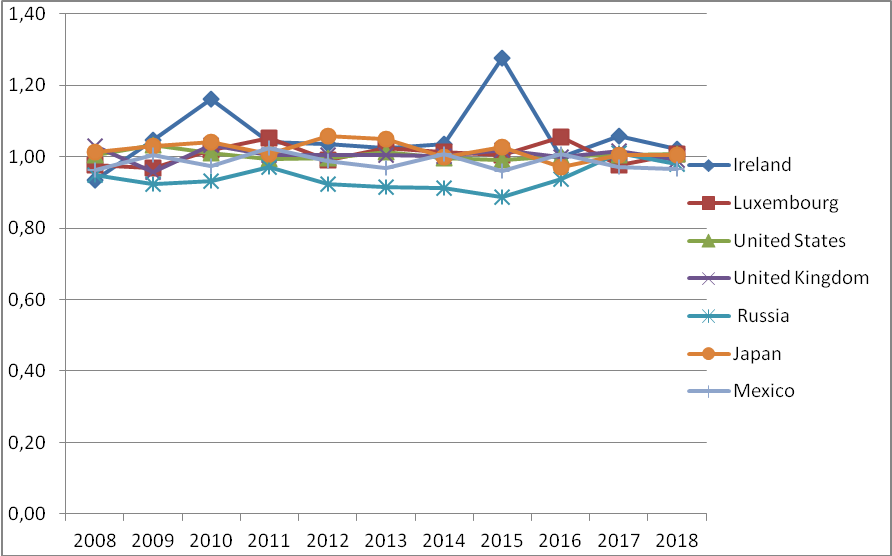
According to the presented calculations, we can make a conclusion that the performance of Russia lags behind. In developed countries, the lead factor exceeds 1, in developing countries it is below 1. That is why, we can conclude that developed countries (Ireland, Luxembourg, the USA, Great Britain, Japan) can mostly be attributed to the second model (see Figure
Among the factors restraining the growth of labor productivity in Russia, D. Medvedev names the lack of incentives for development due to lack of competition, technological inferiority, lack of managerial competencies among company leaders and leaders of governing institutions, lack of investment and inadequacy of legislation (Ilyina & Starostina, 2019), as well as poor automation of production, lack of modern equipment, low qualification of labor forces.
Studies of these two indicators dependence demonstrate that raising wages to a certain level provides a higher level of employees effort (Ehrenberg & Smith, 2009). At the same time, a study by the European Trade Union Institute on the impact of the digital economy on the labor market shows the possibility of increasing labor productivity by facilitating the livelihoods of employees (Degryse, 2016).
Discussion
Speaking about the relationship between labor productivity and salary in the digital economy, let us dwell on the work of Aranzhin (2019), who investigated the relationship between salary and labor productivity. After analyzing data about 48 countries for the year 2018, it was revealed that in countries, which are developed in the field of innovations (Switzerland, Great Britain, Japan, etc.), the correlation between labor productivity and salary is significantly lower than in the countries, which are innovatively underdeveloped (0.51 vs 0.89 in Uruguay, Colombia, Brazil, Peru).
The author explains it by the fact that when innovations and digital technologies are introduced, the influence of other factors (other than salary) on labor productivity becomes more significant.
For example, the level of education of workers, the motivation system, the amount of innovative technologies introduced in production, the climate in the team, intangible incentives, etc. (Kovalenko et al., 2014).
We suggest to pay attention to the nature and essence of these factors. Firstly, they relate not only to the fields of economy and management, but are largely determined by the configuration of social and personal spheres of human life. A symbolically illustrative fact is the growth rate of labor productivity in the USSR: 400% by 1913 shortly before the Great Patriotic War, 1100% by 1959 (The development of the economy of the USSR.., 2020). The achievement of ambitious tasks set “from above” was ensured by exceptional enthusiasm “from below”. Victory in the war intensified the internal motivation of the people, which was not supported by external material incentives.
It should be mentioned that human resource management is crucial in terms of improving labor productivity. “If you correctly build relationships with staff, you can get tremendous returns in the form of increased efficiency, lower costs, and the submission of truly valuable kaizen solutions,” emphasizes O. Chernysheva, deputy director of OOO (limited liability company) Dimitrovgrad valve plant (Talman, 2020).
In December 2017, the autonomous non-profit organization Federal center for competencies in the field of labor productivity was established in Russia. This organization also implies the development of a network of its regional centers. To achieve this goal it is planned to ensure the distribution of knowledge, training and creation of core competencies, the development and implementation of generic solutions and best international practices, including those using the IT platform of managerial and technological solutions, created as part of the implementation of the priority project and accumulating the international experience. However, from the point of view of methodological approaches, specifically between the Japanese productivity center and the Federal center for competencies there is a fundamental difference. For example, the priority area for the Eastern colleagues is working with people (development of personal and professional qualities, labor relations, training systems), and for the Russian center it is the development of production systems and forms of management (Belostotskaya, 2019).
The technocratic approach prevails over historical experience and underestimates the human component. A man cannot be effective if his existential orientation towards creativity and meaning is ignored. Well-balanced management decisions must take into account that only joyful work can be productive. Material incentives must be supplemented with the possibilities of revealing the inner personal potential. Spiritual maturity, a personal strength of a man, as well as his incompleteness will be manifested in his work.
In the next place, the digitalization in Russia at the present time is rather a goal than a finished process. The data from the All-Russian study IT Service Management performed in 2018 demonstrate that despite the fact that more than 80% of the companies participating in the study said they were doing serious work on digitalization, the facts showed the opposite. For example, the current level of use of such trend technologies as AI/ML, Big Data and IoT is only about 10% (Belostotskaya, 2020). The representatives of more than 130 organizations took part in the study. It was a large variety of organizations from IT and telecommunications companies (38%) to the financial sector (12%) and trade (9%).
As for the public sector, the Digital Economy national project has accelerated the process of introducing digital technologies, the volume of investments in this field is increasing annually and the state remains the largest customer in the IT sector. But the low rate of digitalization in total shows that the hope of an increase in labor productivity in the near future (up to 40% according to some researchers) only due to a change in the technological platform can lead to a dead end. It is necessary to ensure the fulfilment of the entire spectrum of possibilities in this field, and to rely not solely on technological solutions, but also on the anthropological foundations, putting them at the forefront.
References
- Aranzhin, V. V. (2019). The relationship of wages and labor productivity: trends in the digitalization of the economy. Labor Economics, 6(1), 524-534.
- Babin, S. I., & Grishkovets, V. B. (1993). Stimulation of labor of personnel of enterprises in industrialized countries: textbook. Allowance. Kemerovo State University.
- Belostotskaya, N. (2019). Increasing productivity in Russia and Japan: what is the difference? Japan Productivity Center vs Federal Competence Center. https://kachestvo.pro/kachestvo-upravleniya/gosinitsiativa/povyshenie-proizvoditelnosti-v-rossii-i-yaponii-v-chem-raznitsa
- Belostotskaya, N. (2020). Management of information technology: trends, problems and prospects. R https://kachestvo.pro/kachestvo-upravleniya/instrumenty-menedzhmenta/upravlenie-informatsionnymi-tekhnologiyami-trendy-problemy-i-perspektivy
- Bodrunov, S. D., Demidenko, D. S., & Plotnikov, V. A. (2018). Reindustrialization and formation of “digital economy”: harmonization of trends through process of innovative development. Administrative consulting, 2(110), 43-54.
- Degryse, C. (2016). Digitalisation of the Economy and its Impact on Labour Markets. European Trade Union Institute.
- Ehrenberg, R. G., & Smith, R. S. (2009). Modern Labor Economics: Theory and Public Policy. (10th Ed.). Pearson.
- Ilyina, N., & Starostina, Yu. (2019). Russia 3.8 times behind Ireland in labor productivity. RBK. https://www.rbc.ru/economics/05/02/2019/5c5872889a794725eb8d815e
- Kovalenko, A. V., Kalinskaya, E. S., & Geleta, I. V. (2014). Directions of labor productivity growth. Economics of sustainable development, 3, 99-104.
- Labor productivity in Russia and in the world. Influence on the competitiveness of the economy and standard of living. (2016). Analytical Bulletin, 29 (628), 8-15.
- OECD.Stat. (2020). https://stats.oecd.org/index.aspx?queryid=54563#
- Prokopyeva, T. V., Prokopyev, A. V., & Popova, A. Yu. (2018). Digital economy – a prospection. Open innovation. Collection of Articles of the Vth International scientific and practical conference, Penza, 97-101.
- Rosstat. (2020). https://www.gks.ru/labor_market_employment_salaries (In Russian).
- Sharpe, A., Arsenault, J. F., & Harriso, P. (2008). The relationship between labour productivity and real wage growth in Canada and OECD countries. Centre for the study of living standards.
- Talman, E. (2020). Progress begins with employees. https://kachestvo.pro/kachestvo-upravleniya/berezhlivoe-proizvodstvo/progress-nachinaetsya-s-sotrudnikov
- The development of the economy of the USSR and the socialist countries as a whole in comparison with the economy of the capitalist countries, II. (2020). http://istmat.info/node/387; http://istmat.info/files/uploads/21357/narhoz_sssr_1959_razvitie.pdf
- Volkova, A. A., Plotnikov, V. A., & Rukinov, M. V. (2019). Digital economy: the essence of the phenomenon, problems and risks of formation and development. Management Consulting, 4(110), 38-49.
Copyright information

This work is licensed under a Creative Commons Attribution-NonCommercial-NoDerivatives 4.0 International License.
About this article
Publication Date
08 March 2021
Article Doi
eBook ISBN
978-1-80296-102-7
Publisher
European Publisher
Volume
103
Print ISBN (optional)
-
Edition Number
1st Edition
Pages
1-644
Subjects
Digital economy, cybersecurity, entrepreneurship, business models, organizational behavior, entrepreneurial behavior, behavioral finance, personnel competencies
Cite this article as:
Laskina, L. Y., Skidan, O. P., & Silakova, L. (2021). The Interrelation Between Labor Productivity And Salary: Economic And Anthropological Aspects. In N. Lomakin (Ed.), Finance, Entrepreneurship and Technologies in Digital Economy, vol 103. European Proceedings of Social and Behavioural Sciences (pp. 521-530). European Publisher. https://doi.org/10.15405/epsbs.2021.03.66

